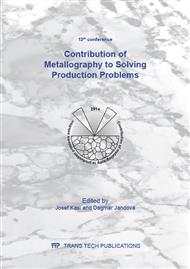[1]
P.I. Patil, R.G. Tated, Comparison of effects of cryogenic treatment on different types of steels: A review, in: IJCA Proceedings on International Conference in Computational Intelligence (ICCIA 2012) ICCIA(9): 21 pages, March 2012. Published by Foundation of Computer Science, New York, USA.
Google Scholar
[2]
R.F. Barron, Cryogenic treatment of materials to improve wear resistance, Cryogenics 22 (1982) 409-414.
DOI: 10.1016/0011-2275(82)90085-6
Google Scholar
[3]
R.H. Naravade, S.B. Belkar, R.R. Kharde, Effects of cryogenic treatment, hardening and multiple tempering on wear behavior of D6 tool steel, The International Journal of Engineering and Science (IJES) 2 (2013) 1-15.
Google Scholar
[4]
D. Mohan Lal, S. Renganarayanan, A. Kalanidhi, Cryogenic treatment to augment wear resistance of tools and die steels. Cryogenics 41 (2001) 149-155.
DOI: 10.1016/s0011-2275(01)00065-0
Google Scholar
[5]
D. Das et al., Effect of deep cryogenic treatment on the carbide precipitation and tribological behavior of D2 steel, Materials and Manufacturing Processes 22. 4 (2007) 474-480.
DOI: 10.1080/10426910701235934
Google Scholar
[6]
D. Das, A.K. Dutta, K.K. Ray, Sub-zero treatments of AISI D2 steel: Part I. Microstructure and hardness, Materials Science and Engineering A527. 9 (2010) 2182-2193.
DOI: 10.1016/j.msea.2009.10.070
Google Scholar
[7]
K. Amini, A. Akhbarizadeh, S. Javadpour, Effect of deep cryogenic treatment on the formation of nano-sized carbides and wear behavior of D2 tool steel, International Journal of Minerals, metallurgy and materials, Vol., 19, No. 9 (2012) p.795.
DOI: 10.1007/s12613-012-0630-2
Google Scholar
[8]
J. Sobotová et al, Diagnostics of the microstructural changes in sub-zero-processed Vanadis 6 P/M ledeburitic tool steel, Materials and Technology 46 (2012) 6, 85-90.
Google Scholar
[9]
P. Bílek, J. Sobotová, P. Jurči, Evaluation of structural changes in Cr-V ledeburitic tool steels depending on temperature austenitization, materials and technology, 44 (2011) 4, 33-37.
Google Scholar
[10]
N.B. Dhokey, J.V. Dandawate, R. Rawat, Effect of cryosoaking time on transitiv in wear mechanism of M2 tool steel, ISRN Tribology 2013 (2013), Article ID 408016, 6 pages, http: /dx. doi. org/10. 5402/2013/408016.
DOI: 10.5402/2013/408016
Google Scholar
[11]
Ch. Gogte, D. Peshwe, R. Paretkar, On the presence of eta carbide in the cryogenically treated high speed steel. Advanced Materials Research, 602-604 (2012) 356- 359.
DOI: 10.4028/www.scientific.net/amr.602-604.356
Google Scholar
[12]
J.Y. Huang, Y.T. Zhu, X.Z. Liao, I.J. Beierlein, M.A. Bourke, T.E. Mitchell, Microstructure of cryogenic treated M2 tool steel. Materials Science Engineering A339 (2003)241-244.
DOI: 10.1016/s0921-5093(02)00165-x
Google Scholar
[13]
S. S. Gill, J. Singh, R. Singh, H. Singh, Metallurgical principles of cryogenically treated tool steels – a review on the current state of sciece, The International Journal of Advanced Manufacturing Technology, 54 (32011) 59-82.
DOI: 10.1007/s00170-010-2935-5
Google Scholar
[14]
V. Leskovšek, M. Kalin, J. Vižintin, Influence of deep-cryogenic treatment on wear resistance of vacuum heat treated HSS, Vacuum 80 (2006) 507-518.
DOI: 10.1016/j.vacuum.2005.08.023
Google Scholar
[15]
S. Zhirafar, A. Rezaeian, M. Pugh, Effect of cryogenic treatment on the mechanical properties of 4340 steel, Journal of Materials Processing Technology 186. 1 (2007) 298-303.
DOI: 10.1016/j.jmatprotec.2006.12.046
Google Scholar
[16]
P. Baldissera, C. Delprete, Effects of deep cryogenic treatment on static mechanical properties of 18NiCrMo5 carburized steel, Materials and Design 30 (2009) 1435-1440.
DOI: 10.1016/j.matdes.2008.08.015
Google Scholar
[17]
H.S. Yang, J. Wang, B.L. Shen, H.H. Liu, S. J Gao, S.J. Huang, Effect of cryogenic treatment on the matrix structure and abrasive resistance of white cast iron subjected to destabilization treatment. Wear 261. 10 (2006) 507-518.
DOI: 10.1016/j.wear.2006.03.021
Google Scholar
[18]
J. Wang et al., Effects of secondary carbide precipitation and transformation on abrasion resistance of the 16Cr-1Mo-1Cu white iron. JMEPEG 15 (2006) 316-319.
DOI: 10.1361/105994906x108602
Google Scholar
[19]
P. Šuchmann, D. Jandová and J. Nižňanská, Deep cryogenic treatment of H11 hot working tool steel, in: Proceedings on MS&T Conference, October 27-31, 2013 Montreal/Canada.
Google Scholar
[20]
F. Meng, K. Tagashira, R. Azuma, H. Sohma, Role of Eta-carbide precipitations in the wear resistance improvements of Fe-12Cr-MoV-1. 4C tool steel by cryogenic treatment. ISIJ International 34. 20 (1994) 205-210.
DOI: 10.2355/isijinternational.34.205
Google Scholar
[21]
D. J. Dyson, K.W. Andrews, Unit cell and space group of the carbide Fe2MoC. Acta Crystallographica 17 (1964) 459.
DOI: 10.1107/s0365110x64001086
Google Scholar
[22]
K.H. Kuo, C.L. Jia, Crystallography of M23C6 and M6C precipitated in low alloy steel. Acta Metallurgica 33 (1985) 991.
DOI: 10.1016/0001-6160(85)90193-2
Google Scholar
[23]
S. Amerlincks, R. Gevers, J. Van Landuyt, Diffraction and Imaging techniques in Material Science. North-Holland Publishing Company, Amsterdam-New York-Oxford, 1978, p.235.
DOI: 10.1016/0160-9327(71)90013-5
Google Scholar
[24]
B. Smola, On determination of the period of lattice parameter modulation from satellite spots spacing in electron diffraction pattern. Czechoslovak Journal of Physics B 31 (1981) 616-619.
DOI: 10.1007/bf01605306
Google Scholar
[25]
D.V. Shitansky, G. Inden, Phase transformation in Fe-Mo-C and Fe-W-C steels. Acta Materialia 45. 7 (1997) 2861-2878.
DOI: 10.1016/s1359-6454(96)00375-8
Google Scholar
[26]
L.I. Lysak, B.I. Nikolin, Fizičeskie osnovy termičeskoj obrabotki stali. Izdatelstvo Technika, Kiev, 1975 (in Russian).
Google Scholar


